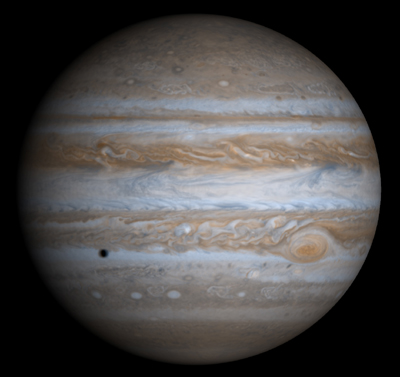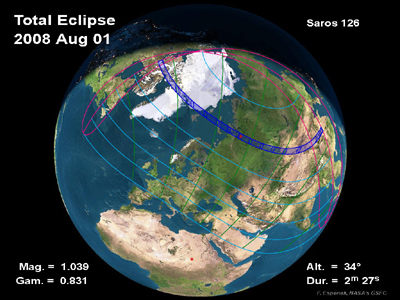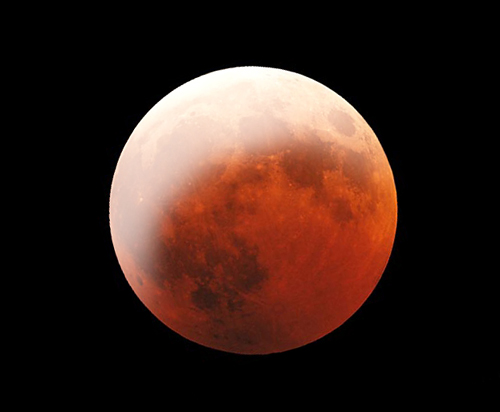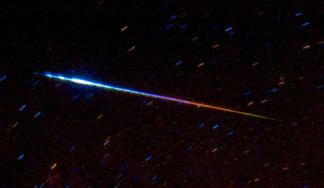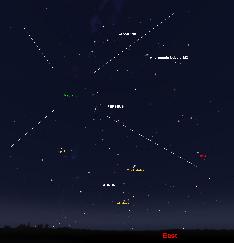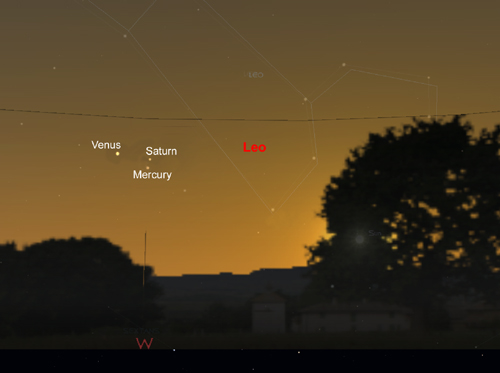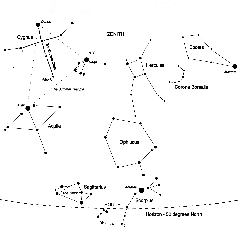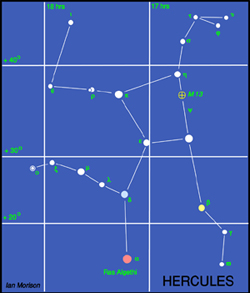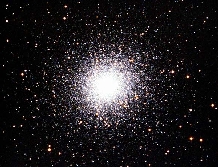The Night Sky August 2008
Compiled by Ian Morison
This page, updated monthly, will let you know some of the things that you can look out for in the night sky. It lists the phases of the Moon, where you will see the naked-eye planets and describes some of the prominent constellations in the night sky during the month.
Image of the Month
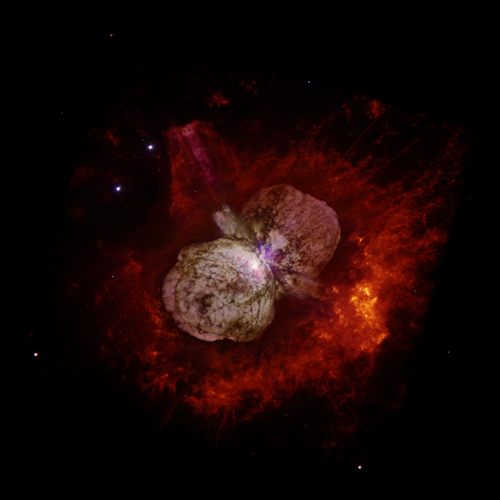
Eta Carina and the Homunculus nebula
Image: N.Smith, J.A.Morse et al. NASA
About 165 years ago, the star Eta Carina became the second brightest star in the sky during an outburst that ejected more mass than that of our Sun. Over time this expanded and Eta Carina became fainter - partly due to its being obscured by the dust from the outburst. Eta Carina is is a very unstable state and still producing unexpected outbursts. It is a prime candidate to provied a spectacular supernovae sometime within the next few million years.
Highlights of the Month
July: Jupiter at its best this year - but, sadly, low in the sky
Jupiter rises in the south-east before sunset during August and is due south in the hours before midnight so is ideally placed for observing. On the first of August it is due south at 22:30 UT (23:30 BST), mid month at ~ 21:40 UT (22:40 BST) and by month's end at 20:23 UT (21:23 BST). It lies in the constellation Sagittarius just up and to the left of the "teapot". This month, as the Earth moves around the Sun "on the inside track" we see Jupiter moving westwards relative to the stars - so called retrograde motion. It begins August at magnitude -2.7 with an angular diameter of 46.3 arc seconds. As we gradually draw further away, these slightly reduce to magnitude -2.6 and 44.4 arc seconds. However, Jupiter is now at the lowest point of the ecliptic in the sky and will only rise to about 16 degrees elevation when it is in the south. Thus, sadly, this year our views of Jupiter from northern latitudes will be rather poor. Despite the low elevation, even a small telescope will show the Galilean Moons as they weave their way around it. Due to refraction, we see Jupiter at very slightly different elevations in the different colours of the spectrum, thus bluring the image. A cleaner image may seen if one observes through a narrow band filter such as a green filter or, even better, if you have an 8" scope or above with a filter like an OIII filter only letting a very narrow band of light through.
August 1st: Total Solar Eclipse - but only partial in the UK.
People across Russia and China will have a chance to see a total eclipse of the Sun during the afternoon of August 1st. But, as the plot above shows, much of Europe will observe a partial Eclipse. Here in the UK the Sun will never be more than ~27% obscured (the north-eastern tip of Scotland) but, for most of England the maximum obscuration will only be of order 14-20% and thus there will be no obvious effects in terms of the Sun's brightness.
The table below give the details of the eclipse for a spread of cities across the UK and should give you an idea of when it can be observed from your own location.
Town First Contact Time of Maximum Eclipse Fourth Contact %obscured
Edinburgh 08:34:21 09:16:43 10:11:10 23.4
Newcastle 08:26:42 09:18:00 10:11:23 21
Manchester 08:27:50 09:16:20 10:06:54 16.8
London 08:33:01 09:18:02 10:04:46 12
Cardiff 08:30:08 09:14:00 09:59:40 11.5
Saturday August 16: A partial Lunar eclipse Eclipse.
If it is clear on the evening of Saturday 16th do look to the southeast after sunset to observe the rising Moon. The Moon first starts entering the umbral shadow of the Earth just 15 minutes later at 20:36 BST (19:36 UT) and, by 22:11 BST, 80% of the Moon will lie within the Earth's shadow with the remainder within the penumbra. We should expect to see the part of the Moon in full shadow a dull red colour with a dazzling northern limb. As the attitude of the Moon will only be 15 degrees above the horizon, the Earth's atmosphere will probably enhance the reddening effect - the low altutude Moon can look pretty red even without an eclipse. It could really look quite impressive! The Umbral shadow leaves the south-western limb of the Moon at 23:44 BST when the Moon has reached an altitude of 22 degrees,
August 11th to 13th: View the Perseid Meteor Shower
If it is clear on the 11th and 12th of August, one will have a chance of seeing the meteors in the Perseid Meteor Shower - the year's most dependable meteor shower. It is not, perhaps,the best year to observe the Perseids as the will be a waxing Moon in the sky for much of the night (Full Moon is on the 16th). The early morning hours will be best. Look up towards the North-East from 10 pm onwards on the nights of August 11th, 12th and 13th. After midnight, as Perseus rises higher into the sky, the numbers seen may well rise too! Most meteors are seen when looking about 50 degrees away from the "radiant" (the point from which the meteors appear to radiate from) which lies between Perseus and Cassiopea. (See the star chart below) The Perseid meteors are particles, usually smaller than a grain of sand, released as the comet Swift-Tuttle passes the Sun. The shower in quite long lived, so it is worth looking out any night from the 10th to the 15th of August. Good hunting!
August 15th: Venus, Mercury and Saturn in conjunction the evening sky
Looking west just after the Sun has set on the evening of the 15th August, you should, if clear, see Mercury and Saturn in close conjunction (just half a degree apart) and just 2.5 degrees to the lower right of Venus. A pair of binoculars will easily put all three in the same field of view. This will probably be a last chance to see Saturn for a month or so. Note: The sky brightness has been reduced to show the locations of the stars and planets.
Observe the International Space Station

The International Space Station and Jules Verne passing behind the Lovell Telescope on April 1st 2008.
Image by Andrew Greenwood
Use the link below to find when the space station will be visible in the next few days. In general, the space station can be seen either in the hour or so before dawn or the hour or so after sunset - this is because it is dark and yet the Sun is not too far below the horizon so that it can light up the space station. As the orbit only just gets up the the latitude of the UK it will usually be seen to the south, and is only visible for a minute or so at each sighting. Note that as it is in low-earth orbit the sighting details vary quite considerably across the UK. The NASA website linked to below gives details for several cities in the UK. (Across the world too for foreign visitors to this web page.)
Note: I observed the ISS three times in the last week or so of July and was amazed as to how bright it has become.
Find details of sighting possibilities from your location from: Location Index
See where the space station is now: Current Position
The Moon

The Moon at 3rd Quarter. Image, by Ian Morison, taken with a 150mm Maksutov-Newtonian and Canon G7.
Just below the crator Plato seen near the top of the image is the mountain "Mons Piton". It casts a long shadow across the maria from which one can calculate its height - about 6800ft or 2250m.
| new | first quarter | full moon | last quarter |
|---|---|---|---|
| August 1st | August 8th | August 16th | August 24th |
Some Lunar Images by Ian Morison, Jodrell Bank Observatory: Lunar Images
The Planets
Jupiter
Jupiter - see highlight above.
Saturn
Saturn is now almost lost in the evening twilight and would need binoculars or a computer controlled telescope be spotted. You might have a chance to spot it when, on the evening of August 13th, it will lie just 14 arc minutes (~1/4 degree) just to the upper left of Venus. See Highlight above.
Mercury
Mercury: At the beginning of August Mercury lies beyond and just to the east of the Sun so is lost in the Sun's glare. However, through the month its angular separation from the Sun increases. (It will reach its greatest angular seperation from the Sun, called "greatest elongation" on September 11th.) It will thus become visible in the evening sky after sunset towards the middle of the month, but its elevation above the horizon is no more than a few degrees as the ecliptic is inclined at a relatively small angle to the ecliptic during August. See highlight above.
Mars
Mars is now so close to the Sun that is virtually lost in the Sun's glare after Sunset. We will have to wait a few months before is can next be seen in the pre-dawn sky.
Venus
Venus starts the month just 14 degrees from the Sun making it difficult to spot in the evening twilight, but its seperations increases to 22 degrees as the month progresses so it will become easier, at magnitude -3.8, to spot just after the Sun has set. See highlight above.
Find more planetary images and details about the Solar System: The Solar System
The Stars
The mid evening August Sky
Having virtually never seen the night sky in July, let's just hope that August will be better! Now that the evenings are drawing it the night sky gets darker earlier so encouraging one to go out to observe.
This map shows the constellations seen towards the south at about 10pm BST in mid August. High over head towards the north (not shown on the chart) lies Ursa Major. As one moves southwards one first crosses the constellation Hercules with its magnificent globular cluster, M13, and then across the large but not prominent constellation Ophiucus until, low above the souther horizon lie Sagittarius and Scorpio. To the right of Hercules lie the arc of stars making up Corona Borealis and then Bootes with its bright star Arcturus. Rising in the east is the beautiful region of the Milky Way containing both Cygnus and Lyra. Below is the constellation of Aquilla, the Eagle. The three bright stars Deneb (in Cygnus), Vega (in Lyra) and Altair (in Aquila) make up the "Summer Triangle".
The constellation Ursa Major
The stars of the Plough, shown linked by the thicker lines in the chart above, form one of the most recognised star patterns in the sky. Also called the Big Dipper, after the soup ladles used by farmer's wives in America to serve soup to the farm workers at lunchtime, it forms part of the Great Bear constellation - not quite so easy to make out! The stars Merak and Dubhe form the pointers which will lead you to the Pole Star, and hence find North. The stars Alcor and Mizar form a naked eye double which repays observation in a small telescope as Mizar is then shown to be an easily resolved double star. A fainter reddish star forms a triangle with Alcor and Mizar.
Ursa Major contains many interesting "deep sky" objects. The brightest, listed in Messier's Catalogue, are shown on the chart, but there are many fainter galaxies in the region too. In the upper right of the constellation are a pair of interacting galaxies M81 and M82 shown in the image below. M82 is undergoing a major burst of star formation and hence called a "starburst galaxy". They can be seen together using a low power eyepiece on a small telescope.
Another, and very beautiful, galaxy is M101 which looks rather like a pinwheel firework, hence its other name the Pinwheel Galaxy. It was discovered in1781 and was a late entry to Messier's calalogue of nebulous objects. It is a type Sc spiral galaxy seen face on which is at a distance of about 24 million light years. Type Sc galaxies have a relativly small nucleus and open spiral arms. With an overall diameter of 170,000 light it is one of the largest spirals known (the Milky Way has a diameter of ~ 130,000 light years).
Though just outside the constellation boundary, M51 lies close to Alkaid, the leftmost star of the Plough. Also called the Whirlpool Galaxy it is being deformed by the passage of the smaller galaxy on the left. This is now gravitationally captured by M51 and the two will eventually merge. M51 lies at a distance of about 37 million light years and was the first galaxy in which spiral arms were seen. It was discovered by Charles Messier in 1773 and the spiral structure was observed by Lord Rosse in 1845 using the 72" reflector at Birr Castle in Ireland - for many years the largest telescope in the world.
Lying close to Merak is the planetary nebula M97 which is usually called the Owl Nebula due to its resemblance to an owl's face with two large eyes. It was first called this by Lord Rosse who drew it in 1848 - as shown in the image below right. Planetary nebulae ar the remnants of stars similar in size to our Sun. When all possible nuclear fusion processes are complete, the central core collpses down into a "white dwarf" star and the the outer parts of the star are blown off to form the surrounding nebula.
The constellation Hercules
Between the constellation Bootes and the bright star Vega in Lyra lies the constellation Hercules.The Red Giant star Alpha Herculis or Ras Algethi, its arabic name, is one of the largest stars known, with a diameter of around 500 times that of our Sun. In common with most giant stars it varies its size, changing in brightness as it does so from 3rd to 4th magnitude. Lying along one side of the "keystone" lies one of the wonders of the skies, the great globular cluster, M13. Just visible to the unaided eye on a dark clear night, it is easily seen through binoculars as a small ball of cotten wool about 1/3 the diameter of the full Moon. The brightness increases towards the centre where the concentration of stars is greatest. It is a most beautiful sight in a small telescope. It contains around 300,000 stars in a region of space 100 light years across, and is the brightest globular cluster that can be seen in the northern hemisphere.
The constellation Virgo
Virgo, in the south-east after sunset this month, is not one of the most prominent constellations, containing only one bright star, Spica, but is one of the largest and is very rewarding for those with "rich field" telescopes capable of seeing the many galaxies that lie within its boundaries. Spica is, in fact, an exceedingly close double star with the two B type stars orbiting each other every 4 days. Their total luminosity is 2000 times that of our Sun. In the upper right hand quadrant of Virgo lies the centre of the Virgo Cluster of galaxies. There are 13 galaxies in the Messier catalogue in this region, all of which can be seen with a small telescope. The brightest is the giant elliptical galaxy, M87, with a jet extending from its centre where there is almost certainly a massive black hole into which dust and gas are falling. This releases great amounts of energy which powers particles to reach speeds close to the speed of light forming the jet we see. M87 is also called VIRGO A as it is a very strong radio source.
Below Porrima and to the right of Spica lies M104, an 8th magnitude spiral galaxy about 30 million light years away from us. Its spiral arms are edge on to us so in a small telescope it appears as an elliptical galaxy. It is also known as the Sombrero Galaxy as it looks like a wide brimmed hat in long exposure photographs.
The constellations Lyra and Cygnus
This month the constellations Lyra and Cygnus are rising in the East as darkness falls with their bright stars Vega, in Lyra, and Deneb, in Cygnus, making up the "summer triangle" of bright stars with Altair in the constellation Aquila below. (see sky chart above)
Lyra
Lyra is dominated by its brightest star Vega, the fifth brightest star in the sky. It is a blue-white star having a magnitude of 0.03, and lies 26 light years away. It weighs three times more than the Sun and is about 50 times brighter. It is thus burning up its nuclear fuel at a greater rate than the Sun and so will shine for a correspondingly shorter time. Vega is much younger than the Sun, perhaps only a few hundred million years old, and is surrounded by a cold,dark disc of dust in which an embryonic solar system is being formed!
There is a lovely double star called Epsilon Lyrae up and to the left of Vega. A pair of binoculars will show them up easily - you might even see them both with your unaided eye. In fact a telescope, provided the atmosphere is calm, shows that each of the two stars that you can see is a double star as well so it is called the double double!
Between Beta and Gamma Lyra lies a beautiful object called the Ring Nebula. It is the 57th object in the Messier Catalogue and so is also called M57. Such objects are called planetary nebulae as in a telescope they show a disc, rather like a planet. But in fact they are the remnants of stars, similar to our Sun, that have come to the end of their life and have blown off a shell of dust and gas around them. The Ring Nebula looks like a greenish smoke ring in a small telescope, but is not as impressive as it is shown in photographs in which you can also see the faint central "white dwarf" star which is the core of the original star which has collapsed down to about the size of the Earth. Still very hot this shines with a blue-white colour, but is cooling down and will eventually become dark and invisible - a "black dwarf"! Do click on the image below to see the large version - its wonderful!
M56 is an 8th magnitude Globular Cluster visible in binoculars roughly half way between Alberio (the head of the Swan) and Gamma Lyrae. It is 33,000 light years away and has a diameter of about 60 light years. It was first seen by Charles Messier in 1779 and became the 56th entry into his catalogue.
Cygnus
Cygnus, the Swan, is sometimes called the "Northern Cross" as it has a distinctive cross shape, but we normally think of it as a flying Swan. Deneb,the arabic word for "tail", is a 1.3 magnitude star which marks the tail of the swan. It is nearly 2000 light years away and appears so bright only because it gives out around 80,000 times as much light as our Sun. In fact if Deneb where as close as the brightest star in the northern sky, Sirius, it would appear as brilliant as the half moon and the sky would never be really dark when it was above the horizon!
The star, Albireo, which marks the head of the Swan is much fainter, but a beautiful sight in a small telescope. This shows that Albireo is made of two stars, amber and blue-green, which provide a wonderful colour contrast. With magnitudes 3.1 and 5.1 they are regarded as the most beautiful double star that can be seen in the sky.
Cygnus lies along the line of the Milky Way, the disk of our own Galaxy, and provides a wealth of stars and clusters to observe. Just to the left of the line joining Deneb and Sadr, the star at the centre of the outstretched wings, you may, under very clear dark skys, see a region which is darker than the surroundings. This is called the Cygnus Rift and is caused by the obscuration of light from distant stars by a lane of dust in our local spiral arm. the dust comes from elements such as carbon which have been built up in stars and ejected into space in explosions that give rise to objects such as the planetary nebula M57 described above.
Deneb,the arabic word for "tail", is a 1.3 magnitude star which marks the tail of the swan. It is nearly 2000 light years away and appears so bright only because it gives out around 80,000 times as much light as our Sun. In fact if Deneb where as close as the brightest star in the northern sky, Sirius, it would appear as brilliant as the half moon and the sky would never be really dark when it was above the horizon!
There is a beautiful region of nebulosity up and to the left of Deneb which is visible with binoculars in a very dark and clear sky. Photographs show an outline that looks like North America - hence its name the North America Nebula. Just to its right is a less bright region that looks like a Pelican, with a long beak and dark eye, so not surprisingly this is called the Pelican Nebula. The photograph below shows them well.
Brocchi's Cluster An easy object to spot with binoculars in Gygnus is "Brocchi's Cluster", often called "The Coathanger",although it appears upside down in the sky! Follow down the neck of the swan to the star Alberio, then sweep down and to its lower left. You should easily spot it against the dark dust lane behind.


